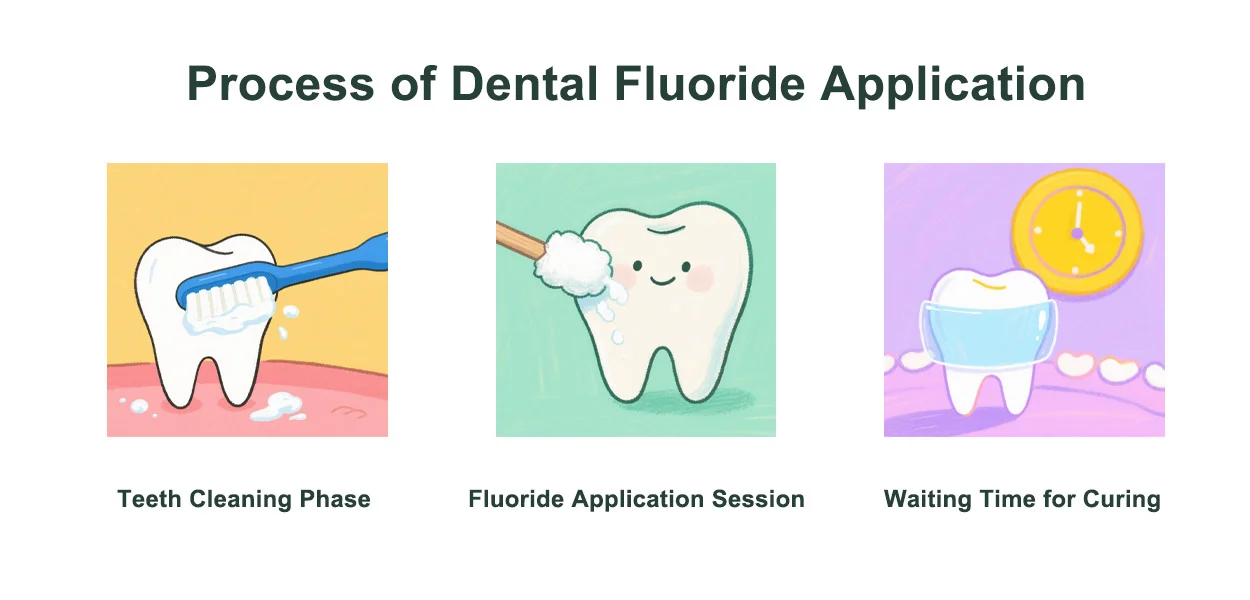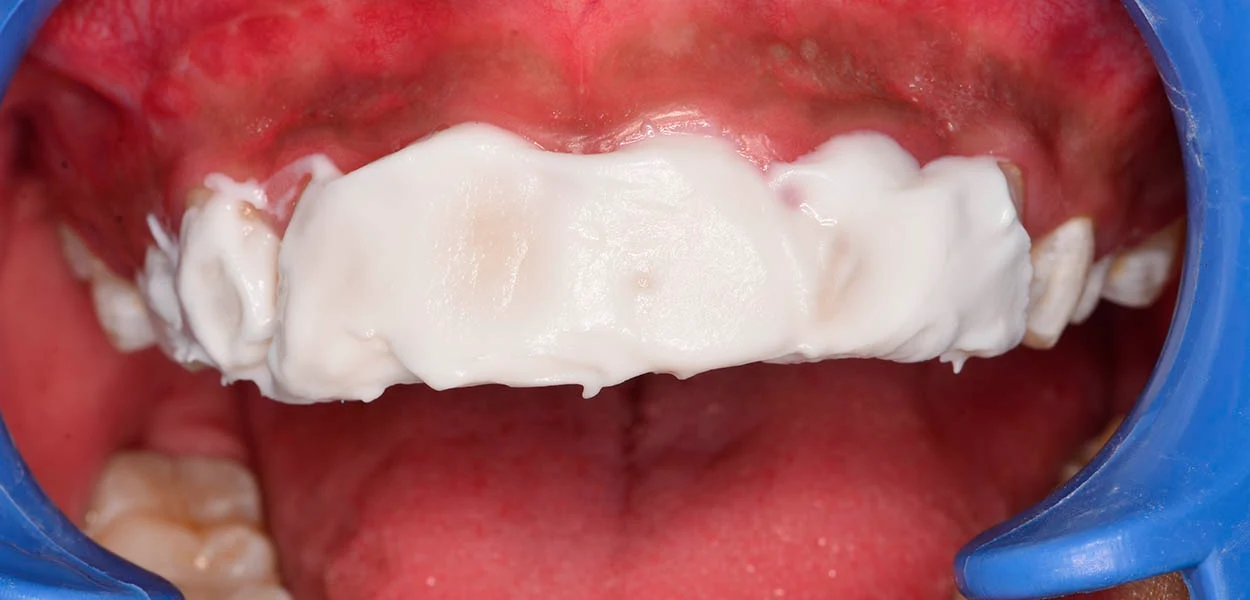In today’s world, with the improvement of living standards, children are consuming more snacks. While they eat and laugh, we often notice their teeth becoming discolored or developing sharp edges. This is the invisible dental disease — dental caries — that accompanies the nutritional benefits of these snacks. We’ve written an article titled Dental Caries Definition and Its Comprehensive Guide, where we explore dental caries in detail. If you’re interested, you can read it here. So, what’s the most effective way for children to eat without worrying about caries? The answer is fluoride.
Let’s explore fluoride treatment: what it is, how it works, and other essential facts about fluoride application.
1. What is fluoride treatment?
Fluoride treatment is the application of fluoride medications, such as fluoride foams and creams, to the teeth. These fluoride medications contain fluoride ions, which adhere to the surface of the teeth. Over time, it slowly works its way into the enamel layer of the tooth. This process is not as complicated as a filling, but is relatively simple and non-invasive. It is usually done by applying a fluoride-containing medication to the surface of the tooth using a fluoride brush. In some cases, fluoride foam trays are used, which are covered with fluoride foam and then placed in the mouth and clenched. This is more effective, as it allows all of the teeth to be immersed in the fluoride foam. Fluoride is a chemical that is extremely beneficial to dental health and is uniquely effective in preventing tooth decay.
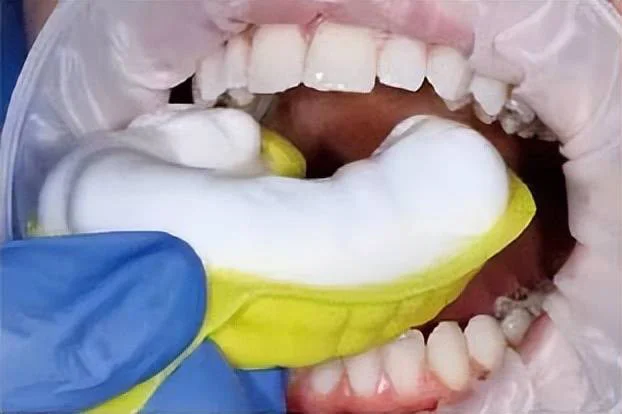
2. Why Fluoride?
I remember when I was a kid, there was a commercial for fluoride toothpaste on TV that played on a loop every day. At that time I wondered why toothpaste emphasized fluoride? What is so special about toothpaste with fluoride? I’m sure many of you may have wondered this. Let’s take a deep dive into the importance of fluoride for our teeth.
2.1 Mechanism of fluoride application for caries prevention
Our teeth are mainly composed of hydroxyapatite, and the bacteria in the mouth will decompose the sugar in the food residues to produce acidic substances. These acids will gradually erode the teeth and lead to demineralization. If left untreated caries will form. Fluoride reacts with the hydroxyapatite of tooth enamel to produce a more stable, acid-resistant fluorapatite. This fluorapatite crystal structure is denser, just like putting a layer of strong “armor” on the teeth, the resistance of tooth enamel to acid is increased by 46%, thus effectively preventing the occurrence of dental caries.
2.2 Benefits of fluoride application
It can promote the remineralization of teeth that have been demineralized to avoid further development of caries. Fluoride can accelerate the deposition of calcium and phosphorus ions in the demineralized areas. Clinical evidence shows that regular fluoride application can enhance the remineralization efficiency of tooth enamel by 70-85%. The probability of preventing further progression of caries is more than 95%.
Fluoridation also inhibits the growth of germs in the mouth. It can interfere with the metabolic process of bacteria, thus reducing the ability of bacteria to produce acid, reducing the formation of caries from the root. 0.02ppm fluoride can inhibit the glycolysis process of Streptococcus pyogenes, reducing acidic metabolites. Epidemiological investigations have shown that the number of caries-causing bacteria in the oral cavity of children who are regularly fluoridated decreases by 35-50%.
This answers the question of why the toothpaste we brush our teeth with emphasizes fluoride. It is because fluoride does wonders for our teeth. Healthy teeth can also be strengthened against caries by using fluoride toothpaste during daily brushing. And if you want better caries protection, it is recommended to visit the dentist regularly for fluoride application.
2.3 What type of people need fluoride?
Anyone who is at a higher risk of developing caries should go to the dentist regularly for fluoride application. For example, children whose teeth are still developing are prone to caries as their enamel is not strong enough to resist the corrosion of acidic substances. Combined with their love for snacks and difficulty maintaining good oral hygiene, leads to a further increase in the risk of dental caries.
Note: Fluoride treatment is also recommended for individuals undergoing orthodontic treatment or those who face challenges in maintaining proper oral hygiene due to special circumstances.
2.4 Three major scenarios for fluoride treatment
2.4.1 Daily care for people with sensitive gums
Fluoridized foam trays that continuously release fluoride ions. Bite for 5 minutes to achieve 40% of the effect of a dental clinic treatment.
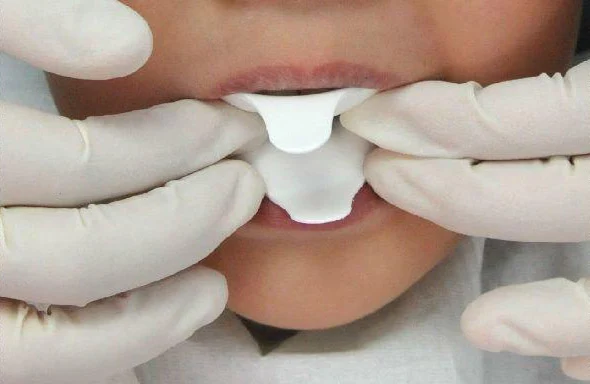
2.4.2 Home care program
Apply calcium fluoride ointment with micro applicator brush after each brushing. This is suitable for people with newly demineralized teeth. It allows for home care that promotes remineralization, saving time and money compared to visiting the dental clinic.
2.4.3 Dental office high concentration fluoride application program
Fluoride Agent: 75% sodium fluoride glycerin paste forms a slow-release film over 12 hours after application. This treatment has a 65.73% effective rate in preventing caries in children’s milk teeth.
Fluoride Gel and dental trays: For orthodontic patients, two treatments per year can reduce the incidence of caries around orthodontic brackets by 41%.
| Type | Fluoride Concentration | Action Time | Annual Usage Frequency |
|---|---|---|---|
| Acidic Fluorophosphate | 1.23% | 4 minutes | 2-4 times |
| Stannous Fluoride | 8% | 1 minute | 2 times |
| Fluoride Varnish | 5% | 24 hours | 2 times |
3. Who Should Receive Fluoride Treatment?
Children: Children are the main beneficiaries of fluoridation. Since children’s teeth are still developing, their enamel is relatively thin and less resistant to caries.
When it comes to fluoride treatment for children, one common question parents ask is, “At what age can my child receive fluoride?”
In fact, is it necessary to apply fluoride to the teeth? When to start? There is no exact age rule, and it is up to the dentist to advise. Depending on the child’s specific situation. Your baby’s teeth should be examined and evaluated in the hospital as early as possible after eruption. As long as he can cooperate with the doctor, you can consider applying fluoride, usually around 2 years old.
As for the frequency of fluoride application, it depends on the child’s high risk of caries, usually every 3-6 months. This helps to build a foundation of good oral health for your child and reduces the risk of developing caries later in life. As your child gets older, he or she will gradually be able to effectively use toothbrushes and floss to maintain good oral hygiene. Once the risk of caries is reduced, the frequency of fluoride application can be reduced.
Adults: Adults can also benefit from fluoride. This is especially true for those who have poor oral hygiene and are prone to caries, as well as those who suffer from oral diseases such as periodontal disease. Fluoride can be used as a complementary oral healthcare tool to help them better maintain their dental health.
Elderly: With age, the teeth of the elderly will show different degrees of wear and gum recession, and the roots of the teeth will be exposed and susceptible to dental caries. Fluoride application can enhance the caries resistance of the tooth roots, protect the dental health of the elderly and improve their quality of life.
4. The complete process of dental fluoride application
4.1 Teeth Cleaning Phase
The dentist will first clean the patient’s teeth with a specialized polishing tool, meticulously removing any remaining food debris, soft tartar, and plaque deposits from the tooth surfaces. This pre-treatment is especially critical – a clean surface allows the subsequent fluoride to work more effectively.
4.2 Fluoride Application Session
Depending on the age of the patient and the condition of the teeth, the doctor will use the appropriate fluoride gel or foam. With the help of a special small brush or cotton swab, the fluoride is gently applied to all surfaces. You may taste a slight sweetness and feel a slight cooling sensation, which is normal.
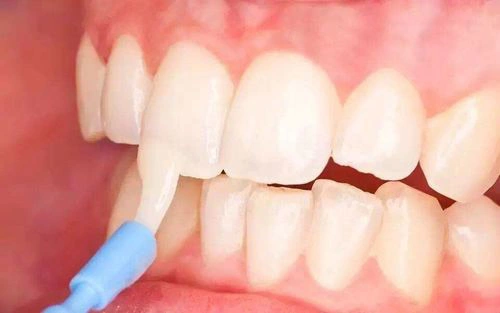
4.3 Waiting Time for Curing
After fluoride application, you will need to remain undisturbed for 30 minutes: do not rinse your mouth, drink or eat. This “resting period” allows the active fluoride ions to penetrate deeply and combine with the minerals in the enamel to form a strong protective layer. It’s like putting an invisible protective coat on your teeth, and the whole process is comfortable and reassuring.
5. Precautions for Fluoride Coating
5.1 Choose a regular medical institution:
Although fluoride application is a common oral health care operation, in order to ensure the safety and effect, you must choose a formal oral health care institution and a professional dentist to perform the operation. The quality of equipment and medicines in formal medical institutions is more guaranteed, and the doctor’s technique is more skillful.
5.2 Inform the doctor of allergy history:
Some people may be allergic to fluoride, and it is important to truthfully inform the doctor of your allergy history before applying fluoride. If there is an allergy, the doctor will choose a suitable alternative or adjust the fluoride application program according to the patient’s specific situation. Also asthmatics should not have fluoride applied, and do not apply fluoride when you have mouth ulcers.
5.3 Control the frequency of fluoride application:
Although fluoride application is good for dental health, it is not better to apply it more frequently. Excessive intake of fluoride may lead to problems like dental fluorosis. Therefore, be sure to follow your doctor’s advice and apply fluoride regularly, and do not increase the frequency of fluoride application on your own.
Pay attention to oral hygiene: Fluoride application is only a means of oral health care and does not replace daily oral cleaning. After fluoride application, you should still maintain good oral hygiene habits, brush your teeth correctly every morning and evening, floss to clean the gaps between your teeth, and have regular oral checkups.
5.4 Precautions after fluoride application:
Generally it is recommended not to eat within half an hour after fluoride application. within 2 hours, you can only eat soft food or liquid food, the temperature should be cool or lukewarm, don’t eat too hot. Do not brush or floss for at least 4-6 hours; it is generally recommended to start brushing the next day.
6. FAQs
Q1. Is it still useful to apply fluoride to teeth that have been demineralized?
Yes!
Fluoride can promote remineralization of teeth and help stop or slow down the rate of caries, so you should not give up even if your teeth are demineralized.
Q2. Is fluoride safe?
Commonly used fluoride coating materials include fluoride protective varnish, fluoride gel and fluoride foam, among which fluoride protective varnish is the most commonly used and most effective. Under regular operation, the amount of fluoride protective varnish used is safe, even if the child accidentally swallows the fluoride on the teeth, it will not harm the health. Proper use does not cause dental fluorosis or fluorosis.
At present, fluoride has been widely used around the world, the technology is mature medical mean. The safety of which has been demonstrated by a number of parties, there is no need to worry about this aspect.
Q3. Can fluoride application replace brushing?
No.
Fluoride is effective in preventing caries, but it doesn’t mean that you won’t get cavities after applying fluoride. Maintaining good oral hygiene is still the most important means of preventing cavities. Such as teaching children to brush and floss correctly and effectively every day, only by developing good oral hygiene habits can cavities be better prevented.
Q4.How often to apply fluoride
It is routinely recommended to apply fluoride once every three months. And for people with low risk of caries, it is recommended to apply fluoride once every six months.
Q5. Does fluoride application hurt?
No, there is no discomfort. During the operation, the doctor first cleans the surface of the teeth with cotton balls and brushes. Then dips a small brush in fluoride and applies it on the surface and sides of the teeth. The application of fluoride on the whole mouth will be completed, and the fluoride will harden quickly to form a protective film.
7. Conclusion
Fluoride treatment, as the gold standard for caries prevention, has been recommended by WHO as a basic oral care measure. Clinical data show that regular professional fluoride treatment can reduce the incidence of dental caries by 40-60%. Let’s pay attention to oral health, actively understand and apply fluoride as a scientific oral health care measure, have a healthy and white teeth, and bloom a confident smile.
